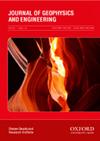A new method for characterization of stress concentration degree of coal mine roadway surrounding rock
IF 1.7
3区 地球科学
Q3 GEOCHEMISTRY & GEOPHYSICS
引用次数: 0
Abstract
An accurate assessment of the stress concentration of the surrounding rock is crucial for ensuring safety in underground coal mines with a high potential for rockburst accidents. Traditional methods for measuring the stress of the surrounding rock use borehole stress monitoring equipment and drilling and cutting methods. However, these methods do not always yield accurate and reliable data. In this study, we aim to explore the feasibility of a novel approach for characterizing stress concentration in surrounding rock using monitoring while drilling (MWD) technology during large-diameter drilling. This study combined microseismic monitoring to collect vibration signals during the drilling process and collection of pulverized coal samples at each drilling stage. We analyzed the amplitude, number of coal vibration events and proportion of coarse pulverized coal. By integrating these indices, we characterized the stress concentration in the surrounding rock. Our approach was validated by comparing accurate, stable, and representative data from deep- and shallow-hole stress gauges installed in similar locations and data from the conventional drilling cutting method. Our findings indicate that the proposed method provides a reliable and effective alternative to traditional techniques during large-diameter drilling. The proposed approach can significantly enhance safety management in underground coal mines prone to rockburst accidents.表征煤矿巷道围岩应力集中程度的新方法
准确评估围岩应力集中度对于确保岩爆事故隐患较大的地下煤矿的安全至关重要。测量围岩应力的传统方法使用钻孔应力监测设备以及钻孔和切割方法。然而,这些方法并不总是产生准确可靠的数据。在本研究中,我们旨在探索一种在大直径钻孔过程中使用随钻监测(MWD)技术来表征围岩应力集中的新方法的可行性。本研究结合微震监测来收集钻井过程中的振动信号,并在每个钻井阶段收集煤粉样本。我们分析了煤振动事件的振幅、次数和粗煤粉的比例。通过综合这些指标,我们对围岩中的应力集中进行了表征。通过比较安装在类似位置的深孔和浅孔应力计的准确、稳定和有代表性的数据与传统钻削方法的数据,验证了我们的方法。我们的研究结果表明,在大直径钻井过程中,所提出的方法为传统技术提供了一种可靠有效的替代方案。该方法能显著提高易发生岩爆事故的煤矿井下安全管理水平。
本文章由计算机程序翻译,如有差异,请以英文原文为准。
求助全文
约1分钟内获得全文
求助全文
来源期刊

Journal of Geophysics and Engineering
工程技术-地球化学与地球物理
CiteScore
2.50
自引率
21.40%
发文量
87
审稿时长
4 months
期刊介绍:
Journal of Geophysics and Engineering aims to promote research and developments in geophysics and related areas of engineering. It has a predominantly applied science and engineering focus, but solicits and accepts high-quality contributions in all earth-physics disciplines, including geodynamics, natural and controlled-source seismology, oil, gas and mineral exploration, petrophysics and reservoir geophysics. The journal covers those aspects of engineering that are closely related to geophysics, or on the targets and problems that geophysics addresses. Typically, this is engineering focused on the subsurface, particularly petroleum engineering, rock mechanics, geophysical software engineering, drilling technology, remote sensing, instrumentation and sensor design.
 求助内容:
求助内容: 应助结果提醒方式:
应助结果提醒方式:


